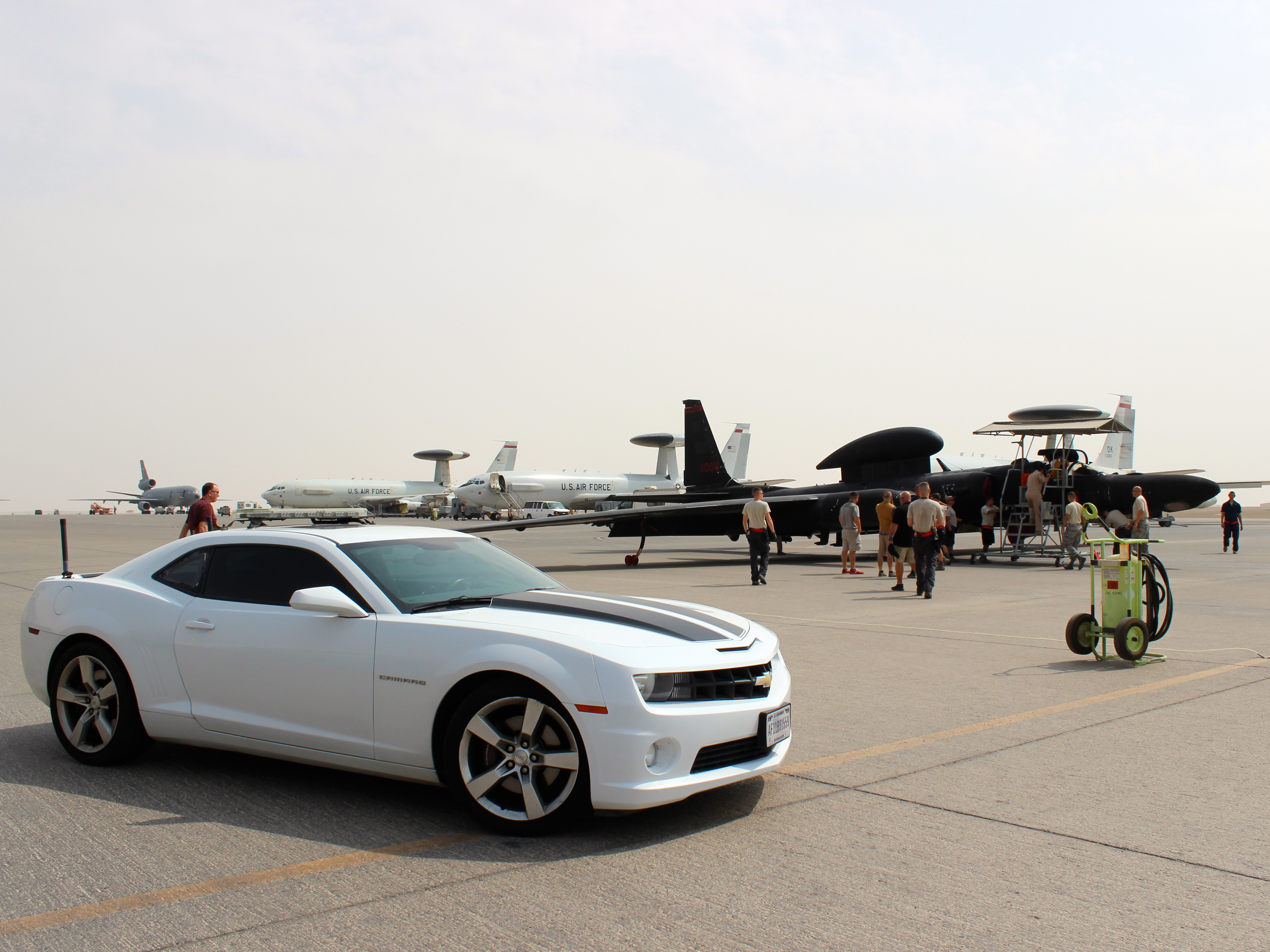A Camaro used as a U-2 chase car sits on the tarmac near the plane its driver helped guide onto the runway at Al Dhafra Air Base, UAE. Photo by Jennifer Hlad.
AL DHAFRA AB, United Arab Emirates—A U-2 pilot sits in a white Camaro at the edge of the runway, peering into the hazy desert sky. A jet appears in the distance, and as it nears, the car’s driver hits the gas, testing the sports car’s acceleration capabilities as he chases the Dragon Lady. The driver keeps one hand on the wheel as he relays the distance between the plane and the runway to the pilot, until finally the plane touches down.
Maj. Cody (The Air Force doesn’tt release full names of pilots deployed down range), the 99th Expeditionary Reconnaissance Squadron U-2 pilot who served as the “mobile,” or chase car driver for the landing, explained that the plane is notoriously difficult to land.
“We don’t really have a landing procedure,” he said. “You want to get the airplane down below 10 feet, and down to about two feet, and then the power’s in idle, so you just want to wait for the airplane to run out of energy.”
The pilot’s goal is to get within two feet of the ground, Cody said, “and then hold it off … because the airplane wants to fall out of the sky. He’s got to demand more lift out of the airplane. And he’s in the idle, so it’s just a matter of time before he runs out of energy to fly and the airplane stalls.”
If the pilot stalls the airplane at three or four feet instead of two, it will break the sensors on the plane, he said; if the plane lands before it’s out of energy, it could run off the runway.
The chase car’s purpose is “to assist the pilot in doing that, because the pilot’s been flying a nine, 10-hour sortie. They’re tired, the airplane doesn’t act predictably, and then they can’t really see the runway,” he added.
Lt. Col. Neal Hinson, deputy commander of the 380th Expeditionary Operations Group and a U-2 pilot, said the physiological issues U-2 pilots face are different than pilots of other air frames.
“Your ass is strapped to an ejection seat for greater than 10 hours a lot of times. In the past, we were exposed to high altitude. We’ve reduced our cockpit altitude now to 14,000 feet, but … it’s hard,” Hinson said. “There is air up there, but … we wear a spacesuit for a reason, because if you’re exposed to it, your eyes pop out, your blood boils, and it gets really gross.”
Hinson likened the U-2 itself to “the most reliable truck,” which carries any payload to high altitude quickly. It “climbs like a homesick angel,” he said.
Whereas most new aircraft are completely integrated, the U-2 was built to carry different payloads to high altitude, and can also power them, even at temperatures of negative 119 degrees Fahrenheit, which the planes saw as recently as last week, Hinson said.
Back down on the ground—where temperatures this time of year hover around 115 degrees Fahrenheit during the day—three airmen jump out of a pickup truck to secure bright orange “pogos” to each of the U-2’s wings, to keep them from dragging on the runway.
The mobile watches from the car nearby, letting the pilot know when the pogos are ready, then helps the pilot steer the plane to its parking spot. Once there, a team of airmen and civilians help the man in the bright yellow space suit out of the plane, and he immediately uses a water bottle to wash something out of his eye—it’s the first time he’s been able to touch his face for upwards of 10 hours.


